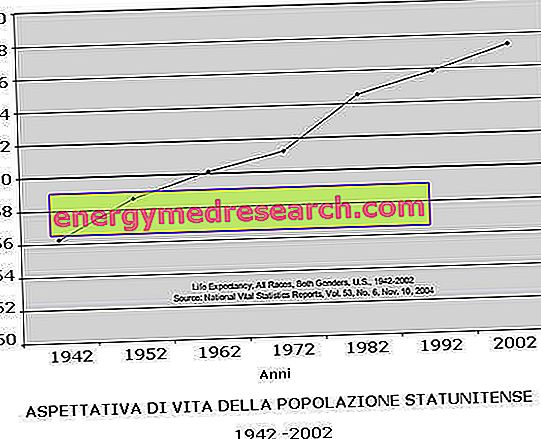There is overweight and overweight ...
According to the "classic" definition, being overweight is a physical condition linked to an excess of body weight compared to the values considered normal based on height. In reality, this definition is as banal as it is inaccurate; in fact, overweight is certainly not identified in the absolute value of body mass in relation to height, but in the ratio between the fat-free mass (FFM) and the fat mass (FM). This clarification is essential to say the least, since
an "excess", so to speak, of fat-free mass is certainly not a pathology (far from it!), while an excess of the fat mass (EXCLUSIVELY considered as adipose, excluding essential fat) can compromise the lifestyle and the state of health of the subject.
On the other hand, it is also worth pointing out that in a "normal" subject not involved in muscle building activities (such as body building, weight lifting, power lifting and other disciplines that require an increase in muscular trophism), the overweight is VERY RARELY dependent from an "excess" of fat-free mass.

What can manifest itself is a DIFFERENT LEVEL OF GRAVITY OF THE OVERWEIGHT.
Let's try to be clearer.
The overweight is identified and evaluated mainly through the Body Mass Index (BMI) or Body Mass Index (BMI). This equation correlates the height (expressed in meters - raising it squared) to the weight (expressed in kilograms), that is: h2 / kg. The overweight is estimated with a value greater than or equal to 25.0; beyond 29.9 it is necessary to highlight the gravity of the excess weight with the term of OBESITY and its various levels.
Deepening on BMI and online calculation
Obviously, since it is a measurement that DOES NOT take into account the importance of the fat-free mass, it is absolutely necessary that the BMI is at least expanded by the estimate of the bone constitution and the morphological type.
BMI | CONDITION |
| <16.5 | SERIOUS MAGREE |
16 to 18.49 | UNDERWEIGHT |
18.5-24, 99 | normal weight |
25 to 29.99 | OVERWEIGHT |
| 30 to 34.99 | CLASS I OBESITY (mild) |
35 to 39.99 | CLASS II OBESITY (average) |
> 40 | OBESITYCLASSES III (serious) |
The first evaluates the thickness of the skeletal segments (measurable with the circumference of the contralateral wrist compared to the dominant, taken at the narrowest point), while the second estimates the relationship between the thickness of the bones with the stature.
The difference in constitution and morphological type affects the fat-free mass, hence the body weight; this means that every subject has a desirable physiological weight (the one that implies 15% of fat mass in humans and 24% in women) to which a certain BMI corresponds. The scope of normality between slender and strong short-limbed slender people (lower and upper extremes of the range) is between 18.5 and 24.9 of BMI.
In conclusion, statistically physiological BMI desirable for sedentary subjects ≥ 25.0 are not statistically significant (which means that overweight always corresponds to 25.1); however, the severity of either excess weight may be quite different depending on the case.
An overweight subject with a BMI of 26.0, having desirable physiological IMC of 18.5, has a certainly more severe excess fat compared to a subject of the same BMI but with desirable physiological BMI of 24.9.
Evaluation of overweight: is it dangerous?
To answer a similar question it is necessary to clarify some points.
First of all, speaking of overweight, we exclude obesity conditions for a moment and only consider the BMI range between 25.0 and 29.9. Secondly, I want to clarify that being overweight is always harmful to health BUT not for everyone alike. Here, variables such as the distribution of fat (android or gynoid), sex, age, metabolic factors, genetic or family predispositions to certain diseases, the level of physical motor activity, overall nutrition, etc. come into play. Without going too far, as the archive of our site is already sufficiently provided, below we will focus on the mere estimation of body measurements, more precisely of the waist circumference as well as of the waist / hip ratio (WHR) in overweight subjects.

Suffer from abdominal and / or visceral overweight are men and women after menopause (in this case, due to a change in the hormonal axis). The pathologies most frequently associated with the condition in question are: hyperlipemias and dyslipidemias (total and LDL hypercholesterolemia, hypertriglyceridemia, HDL hypocholesterolemia), reduced glucose tolerance - hyperinsulinemia - type 2 diabetes mellitus, arterial hypertension, hyperuricemia, increased systemic inflammation (identifiable with of blood markers, like the C-reactive protein), atherosclerosis and cardio-circulatory compromises. Gastro-intestinal diseases, liver disorders, kidneys, etc. are also statistically present.

The most used method consists in measuring the waist circumference taken at the narrowest point with respect to the frontal plane (approximately in the umbilical region). The detection must be performed with a metric tape, without clothes and without tightening too much; the measurement is expressed in centimeters and should be placed on a different scale between a man and a woman. For men, the risk increases when it exceeds 95cm, while for women, if they exceed 80cm (we leave out the severity scale, as in the overweight we are unlikely to have very high values, which are frequent in obesity).
The circumference of life alone may sometimes not be enough; it is a datum that does not take into consideration the muscular and skeletal dimensions of the subject; therefore, before assessing with certainty the "gravity" of the android-type overweight, it is necessary to understand if it is actually an "apple" conformation. To do this it is sufficient to perform a rapid WHR (Waist to Hip Ratio) test. This foresees, with the previous method, the measurement of the waist circumference and that of the hips (on the frontal plane this corresponds to the maximum gluteal prominence, or the widest point). Dividing the first measure by the second one produces a coefficient; this confirms the overweight android only if> 0.85 in men and> 0.79 in women.
In summary, to verify the presence of overweight and to guess what its gravity may be, it is necessary to: calculate the BMI, adapt it to the constitution and morphological type, estimate the waist circumference and check with the WHR whether the abdominal - visceral excess is android type.
Examples of overweight: one of little importance and another of concern
Taking for granted that what has been described so far is clear enough, let us try to bring everything "back on the field". Below I will cite two examples of overweight (actually identified): one of little health importance and the other worrying.
Example 1 : male, 30 years old, ex-rugby player who is currently in form at amateur level, BMI 27, robust constitution and morphological type normolineo, waist circumference 98cm, WHR 0.85, blood values and pressure within the norm, no familiarity with cardio-circulatory impairments or metabolic diseases.
It is evident that the subject is overweight and that, objectively, he must reduce his fat mass. However, considering the age, the anthropometric characteristics and the other risk factors (absent), it is possible to affirm that (statistically) this subject is not "among the most ill". Furthermore, the athlete's past and good muscle mass compared to the norm are also positive factors. We would like to remind you that it would be desirable to reduce overweight in order to prevent it from getting worse by evolving into obesity and compromising the health and quality of life.
Example 2: female, 55 years old and menopausal, housewife always, had 3 children, BMI 26.5, slender constitution and morphological type normolineo, waist circumference 94cm, WHR 0.80, chronic hypertension and with glycaemia altered by only one year. The overweight is worsening.
It is equally clear that this person is, in contrast to the previous case, a person at risk. The distribution of the fat tends to be android, the overweight is therefore concentrated in the abdominal band and, in addition to a primary hypertension, progressively there is an impairment of the glucose tolerance probably associated with hyperinsulinemia. A past of sedentary life and the current inactivity compromise the balance between FFM and FM worsening the general state of health. We need a reduction in fat mass through diet and constant sports.
From the above it emerges that, in addition to the detection of the overweight, to monitor the state of greeting are also necessary: the assessment of fat distribution, past and present lifestyle, metabolic and hereditary risk factors, etc.



